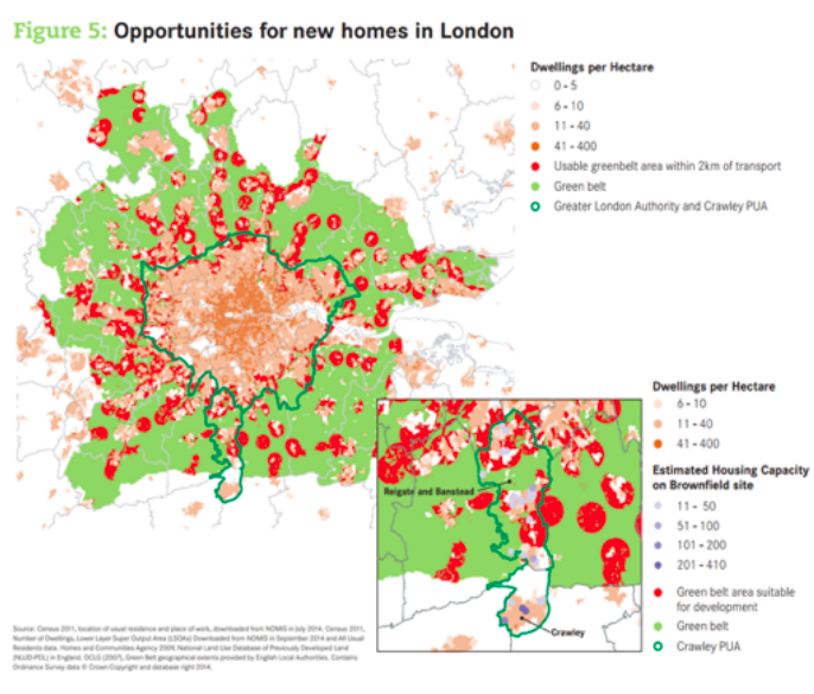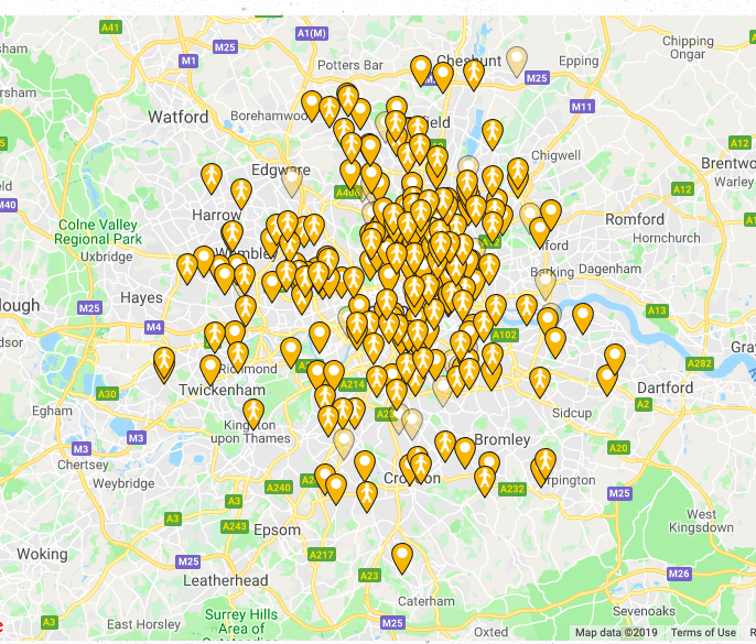
The zoning map of London translated into a comprehensive sketch
The infographic on the left presents a snapshot of London’s development as it stands today, with a stark contrast between the built-up residential and commercial land uses of the inner boroughs, and the more mixed land uses of agriculture, leisure and housing around the perimeter. As the city’s population continues to grow, pressure to build on the Green Belt mounts, despite the known advantages of safeguarding green spaces in cities.
To prevent this, some campaigners and researchers argue for a vertical re-envisioning of the city, with more dense and higher buildings constructed to reduce the urban ecological footprints. However, a vertical city approach does not always consider the existing urban fabric which planners and policymakers are working with, or how communities could best be supported to meet their needs sustainably starting with the existing pattern of land use and ownership. For example, in suburban environments where housing is often low-density, there are opportunities to rethink how land is used, and to see these areas as potential resources for the city ecosystem, in terms of food production, waste, and natural systems. This approach is horizontal in nature. London’s current approach to food production, reliance on natural systems and waste is unsustainable. A third of all food in the capital is wasted, but there are opportunities to experiment with circular or closed loop production systems (e.g. using waste from restaurants to fertilise crops which are then sold back to eateries).
In this context, urban farming and food growing projects across the city and particularly in peri-urban environments (detailed in the next chapter), such as OrganicLea, Sutton Community Farm and Cultivate London are seeking to shift the role of food growing in London, to boost local economies, provide livelihoods, and make London socially and environmentally sustainable. Other initiatives, like London National Park City which is seeking to reimagine the city as a park that people live in and to ‘make the city wilder’, are also recognising it as an ecosystem and blurring the boundaries between urban and rural.
On this page, we explore the competing demands upon London’s land, and the pressures this places on food growing spaces throughout the city.
The Green Belt
The Green Belt is the main protection for farming in London, as the London Plan and national planning policy protect it from being built on. Food growing is rarely prioritised in the UK’s current system of planning when compared to alternative uses, and even Green Belt land can be de-designated, without consideration of the best use of the land. Land is classified on a six-point scale for soil quality, and only the top three grades have some protection under planning rules. There is no specific provision in the London Plan related to soil quality. This leaves land use to be determined by market forces that may not recognise the social and environmental benefits of agricultural uses of land. Once land has been built over, it is unlikely to return to agricultural use.
However, there are many potential positive aspects to having a green area around and at the edges of the city. It cools and cleans the air, provides a habitat for wildlife and links wildlife populations, provides natural space for urban dwellers to enjoy, and absorbs rainwater to prevent flooding.
Producing food close to where it is consumed could also reduce the footprint of London’s food consumption. Currently, food produced in Greater London, especially from Green Belt farms, is produced using intensive farming methods and typically exported for consumption elsewhere. In debates on whether the Green Belt is outdated and whether it should exist, arguments tend to focus on the need for housing and supporting infrastructure. However, much less weight and consideration is given to the potentially positive role that agriculture in the Green Belt could play in the ecology of the city. This has led to a situation in which farmland is increasingly encroached upon as the city expands, through both development and change of use, even as that expansion is controlled through strict planning policy.
Contested Land Use

Housing density in London
The 2017 Strategic Housing Market Assessment, published alongside the draft London Plan, identified a need for 66,000 new homes in London every year. This is as a result of faster population growth, an ageing population, a backlog of unmet need and rising house prices. But as well as housing, there are demands on land for development for infrastructure and commercial purposes to support economic growth, and for recreational land for people who live in the area. These pressures appear both in the market, and in terms of how local authorities use their land. In addition to these real economy pressures, the increasing value of land has both increased incentives for landowners to ‘landbank’ and only offer short-term tenancies with a view to developing the land in future, and local authorities to sell the land they do own. This reduces the availability of land for food production, pushes up prices and can place farmers in an insecure position.
Land use and development in London is guided by the London Plan, produced by the Mayor and published by the Greater London Authority.
On being elected Mayor of London in 2017, Sadiq Khan promised to develop a New London Plan to address the issues of pressure of a fast-growing population, increasing diversity of Londoners, rising inequality, uncertainty caused by the EU referendum result and the effects of climate change.
The draft New London Plan is currently being revised following public consultation, and groups including Sustain[50] (and NGO that campaigns for better food and farming) and JustSpace (an informal alliance of around 80 community groups, campaigns and independent organisations) have been involved in lobbying to ensure protections and support for community food growing and food production are included in the plan.
Pressure for London’s planning policies to support more farming activity have been long-standing, reflected in the 2010 Cultivating The Capital report by the London Assembly’s Planning and Housing Committee which made specific recommendations for the London Plan, including identifying food growing as a particularly desirable use in the Green Belt that should be given the same weight as other uses, such as outdoor recreation, and to open up land within London for food growing including ‘temporary and unconventional food growing operations’. More recently the London Assembly Environment Committee has made a range of recommendations to protect and encourage farming in the Green Belt. These include:
creating an accessible database of agricultural landownership and availability alongside model leases or other tools to help farmers get and retain land tenure without excessive costs
the London Plan, the Green Belt and Food Growing policies should include a requirement for boroughs to give added weight in local development plans to food growing in the Green Belt
explore the potential to support a ‘grown in London’ food brand
opportunities to support and promote farming methods that maximise environmental and social benefits and support his other policy goals, such as renewable energy generation, should be explored
These issues of contested land use are are also the subject of national policy debate, with the Campaign to Protect Rural England (CPRE) calling for the development of national land use strategy to enable better management of the pressures on land for housing and development, and to revise the National Planning Policy Framework and national planning guidance to recognise land and soils for the role they play, and to minimise their degradation.
Smaller scale food production in London
Food growing as an activity within the bounds of Greater London extends beyond large-scale farms and commercial agriculture. It also takes place in food-growing projects that may have social and educational purposes, in city farms, and on allotments. While only 3,000 are classified as working within the agriculture sector in London, over 200,000 Londoners are involved in food-growing. While often small in terms of land-area used, 2,700 new food growing spaces have been set up in the last decade. These growing spaces are in schools, housing estates and parks and on the peri-urban fringe.

Map of Gardens in London, as accessed in August 2019. Find the current map by clicking here
In 2006 the GLA gathered data on allotments in London were part of, or based on this work. The research found that there were 736 sites. The number and density varied by borough: there were no sites in the central London boroughs of the City of London, Kensington and Chelsea, and Westminster, and the largest numbers of allotments per head were in outer London boroughs, but some outer boroughs (for example Croydon) also had few sites. The research also found that the number of allotments, and the land area of allotments, was in decline. Between 1996 and 2006, an estimated 1534 plots equivalent to 87 acres were lost. This has in large part occurred through sustained ‘chipping away’ of a few plots at a time, as pressure on land for housing and other development has increased. At the same time, demand for allotments has increased, with 4,300 people on allotment waiting lists in London in 2006 (up by 3,000 people in a decade), showing the resurgent interest in ‘growing-your-own’ amongst Londoners.
Together, all these types of urban growing spaces can contribute to increasing London’s food security and sovereignty. More than 2.3 million Londoners live below the poverty line, with 33% of adults having skipped meals to save money so their children can eat, and parts of the city are ‘food deserts’ – areas poorly served by food stores, particularly those selling fresh, healthy products. Expanding urban and peri-urban farming throughout the city could be a means of engaging communities in addressing these issues by growing, cooking and eating healthy foods with low carbon footprints.
However, the value of these growing spaces lies not just the end produce or the ecosystem services they enable, but in the act of growing itself. As well as the therapeutic effects of gardening, growing spaces can act as sites of resistance in which people experiment with more equitable and collaborative ways of living, essential for nurturing the emergence of urban agroecology in London. These more intangible benefits of food growing spaces should also be considered in planning decisions, which may be aided by seeing the urban landscape as an ecosystem, and seeing a farm as both a nexus connecting the flows of a range of resources and as a site for their management.
https://www.london.gov.uk/what-we-do/business-and-economy/food/our-projects-food-london/food-poverty-action-plans [Accessed 23 August 2019]
London Assembly (2018) Farming in London’s Green Belt [online] Available at: https://www.london.gov.uk/sites/default/files/farminginlondonsgreenbelt.pdf [Accessed 23 August 2019]
Greater London Authority (2018) The London food strategy [online] Available at: https://www.london.gov.uk/sites/default/files/final_london_food_strategy.pdf [Accessed 23 August 2019]
Greater London Authority (2017) The 2017 London Strategic Housing Market Assessment [online] Available at: https://www.london.gov.uk/sites/default/files/london_shma_2017.pdf [Accessed 23 August 2019]
London Assembly (n.d.) New London Plan [online] Available at: https://www.london.gov.uk/what-we-do/planning/london-plan/new-london-plan [Accessed 23 August 2019]
London Food Link and Sustain (2018) London Food Link response to the draft New London Plan [online] Available at: https://www.sustainweb.org/resources/files/responses/Response_to_London_Plan.pdf [Accessed 23 August 2019]
JustSpace (2018) Just Space response to draft London Plan [online] Available at: https://justspacelondon.files.wordpress.com/2018/02/js-on-chapter-8.pdf [Accessed 23 August 2019]
London Assembly (2010) Cultivating the Capital: Food growing and the planning system in London [online] Available at: https://www.london.gov.uk/sites/default/files/gla_migrate_files_destination/archives/archive-assembly-reports-plansd-growing-food.pdf [Accessed 23 August 2019]
CPRE (2017) Landlines: why we need a strategic approach to land [online] Available at: https://www.cpre.org.uk/resources/countryside/item/4534-landlines-why-we-need-a-strategic-approach-to-land [Accessed 23 August 2019]
CPRE (2018) Back to the land: rethinking our approach to soil [online] Available at: https://www.cpre.org.uk/resources/farming-and-food/farming/item/5013-back-to-the-land-rethinking-our-approach-to-soil [Accessed 23 August 2019]
Sustain (2019) Capital Growth [online] Available at: www.capitalgrowth.org [Accessed 23 August 2019]
Sustain (2019) Big Dig [online] Available at: https://www.bigdig.org.uk/map/london/# [Accessed 23 August 2019]
Greater London Authority (2006) A lot to lose: London’s disappearing allotments [online] Available at: https://www.london.gov.uk/about-us/london-assembly/london-assembly-publications/lot-lose-londons-disappearing-allotments pp. 38-39 [Accessed 23 August 2019]
London Assembly (n.d.) Food Poverty Action Plans [online] Available at: https://www.london.gov.uk/what-we-do/business-and-economy/food/our-projects-food-london/food-poverty-action-plans [Accessed 23 August 2019]
Corfe, S. (2018) What are the barriers to eating healthily in the UK? [online] Available at: http://www.smf.co.uk/wp-content/uploads/2018/10/What-are-the-barriers-to-eating-healthy-in-the-UK.pdf p. 21 [Accessed 23 August 2019]